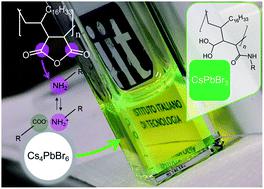当前位置:
X-MOL 学术
›
Chem. Sci.
›
论文详情
Our official English website, www.x-mol.net, welcomes your
feedback! (Note: you will need to create a separate account there.)
Transforming colloidal Cs4PbBr6 nanocrystals with poly(maleic anhydride-alt-1-octadecene) into stable CsPbBr3 perovskite emitters through intermediate heterostructures.
Chemical Science ( IF 7.6 ) Pub Date : 2020-03-20 , DOI: 10.1039/d0sc00738b Dmitry Baranov 1 , Gianvito Caputo 1 , Luca Goldoni 2 , Zhiya Dang 1 , Riccardo Scarfiello 3 , Luca De Trizio 1 , Alberto Portone 4 , Filippo Fabbri 4 , Andrea Camposeo 4 , Dario Pisignano 4, 5 , Liberato Manna 1
Chemical Science ( IF 7.6 ) Pub Date : 2020-03-20 , DOI: 10.1039/d0sc00738b Dmitry Baranov 1 , Gianvito Caputo 1 , Luca Goldoni 2 , Zhiya Dang 1 , Riccardo Scarfiello 3 , Luca De Trizio 1 , Alberto Portone 4 , Filippo Fabbri 4 , Andrea Camposeo 4 , Dario Pisignano 4, 5 , Liberato Manna 1
Affiliation

|
The preparation of strongly emissive CsPbBr3 perovskite nanocrystals with robust surface passivation is a challenge in the field of lead halide perovskite nanomaterials. We report an approach to prepare polymer-capped CsPbBr3 perovskite nanocrystals by reacting oleylammonium/oleate-capped Cs4PbBr6 nanocrystals with poly(maleic anhydride-alt-1-octadecene) (PMAO). PMAO contains succinic anhydride units that are reactive towards the oleylamine species present on the Cs4PbBr6 nanocrystals' surface and produces polysuccinamic acid, which, in turn, triggers the Cs4PbBr6 to CsPbBr3 conversion. The transformation occurs through the formation of Cs4PbBr6–CsPbBr3 heterostructures as intermediates, which are captured because of the mild reactivity of PMAO and are investigated by high-resolution electron microscopy. The Cs4PbBr6–CsPbBr3 heterostructures demonstrate a dual emission at cryogenic temperature with an indication of the energy transfer from Cs4PbBr6 to CsPbBr3. The fully-transformed CsPbBr3 NCs have high photoluminescence quantum yield and enhanced colloidal stability, which we attribute to the adhesion of polysuccinamic acid to the NC surface through its multiple functional groups in place of oleate and alkylammonium ligands. The PMAO-induced transformation of Cs4PbBr6 NCs opens up a strategy for the chemical modification of metal halide NCs initially passivated with nucleophilic amines.
中文翻译:

通过中间异质结构将胶体 Cs4PbBr6 纳米晶体与聚(马来酸酐-alt-1-十八碳烯)转化为稳定的 CsPbBr3 钙钛矿发射体。
制备具有强表面钝化能力的强发射CsPbBr 3钙钛矿纳米晶是卤化铅钙钛矿纳米材料领域的一个挑战。我们报道了一种通过油铵/油酸盐封端的Cs 4 PbBr 6纳米晶体与聚(马来酸酐-alt -1-十八碳烯)(PMAO)反应来制备聚合物封端的CsPbBr 3钙钛矿纳米晶体的方法。 PMAO 含有琥珀酸酐单元,可与 Cs 4 PbBr 6纳米晶体表面上存在的油胺物质发生反应,并产生聚琥珀酸,进而引发 Cs 4 PbBr 6向 CsPbBr 3的转化。该转化是通过形成 Cs 4 PbBr 6 –CsPbBr 3异质结构作为中间体而发生的,由于 PMAO 的温和反应性,这些异质结构被捕获并通过高分辨率电子显微镜进行研究。 Cs 4 PbBr 6 –CsPbBr 3异质结构在低温下表现出双重发射,并表明能量从Cs 4 PbBr 6转移到CsPbBr 3 。 完全转化的CsPbBr 3 NCs具有高光致发光量子产率和增强的胶体稳定性,这归因于聚琥珀酸通过其多个官能团代替油酸酯和烷基铵配体粘附到NC表面。 PMAO 诱导的 Cs 4 PbBr 6 NC 转化开辟了一种对最初用亲核胺钝化的金属卤化物 NC 进行化学修饰的策略。
更新日期:2020-04-24
中文翻译:

通过中间异质结构将胶体 Cs4PbBr6 纳米晶体与聚(马来酸酐-alt-1-十八碳烯)转化为稳定的 CsPbBr3 钙钛矿发射体。
制备具有强表面钝化能力的强发射CsPbBr 3钙钛矿纳米晶是卤化铅钙钛矿纳米材料领域的一个挑战。我们报道了一种通过油铵/油酸盐封端的Cs 4 PbBr 6纳米晶体与聚(马来酸酐-alt -1-十八碳烯)(PMAO)反应来制备聚合物封端的CsPbBr 3钙钛矿纳米晶体的方法。 PMAO 含有琥珀酸酐单元,可与 Cs 4 PbBr 6纳米晶体表面上存在的油胺物质发生反应,并产生聚琥珀酸,进而引发 Cs 4 PbBr 6向 CsPbBr 3的转化。该转化是通过形成 Cs 4 PbBr 6 –CsPbBr 3异质结构作为中间体而发生的,由于 PMAO 的温和反应性,这些异质结构被捕获并通过高分辨率电子显微镜进行研究。 Cs 4 PbBr 6 –CsPbBr 3异质结构在低温下表现出双重发射,并表明能量从Cs 4 PbBr 6转移到CsPbBr 3 。 完全转化的CsPbBr 3 NCs具有高光致发光量子产率和增强的胶体稳定性,这归因于聚琥珀酸通过其多个官能团代替油酸酯和烷基铵配体粘附到NC表面。 PMAO 诱导的 Cs 4 PbBr 6 NC 转化开辟了一种对最初用亲核胺钝化的金属卤化物 NC 进行化学修饰的策略。











































 京公网安备 11010802027423号
京公网安备 11010802027423号